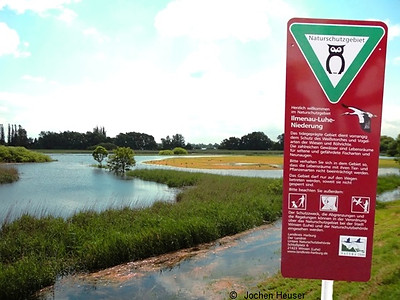Nature reserves
Untere Seeveniederung Nature Reserve
Visitors to the 400-hectare Untere Seeveniederung nature reserve, between Winsen (Luhe) and Hamburg, can expect a large, open Elbe marsh meadow landscape. Today the wide wet meadows of Junkernfeld in particular offer the rare sight of an old grassland dominated marsh landscape.
Snake's head fritillary in Junkernfeld
They have a very special meaning because it is probably the largest occurrence in Central Europe. In particular the wide wet meadows of the Junkernfeld today offer the rare sight of an old grassland dominated marsh landscape. Between mid-April and mid-May, the snake's head fritillary blooms in the Junkernfeld by the thousand, especially in the northern part. Even if the plants with the graceful flowers are not blooming, the species-rich wet meadows with cuckoo flower, ragged robin, the pink flowering common bistort, meadow buttercup, and marsh marigold offer a refreshing sight on a circular walk in the spring and early summer. Information panels give details about the specialities of nature in Seeveniederung.

© Gemeinde Stelle
Junkernfeld Nature Reserve
Since 1 December 2014, Ilmenau-Luhe-Niederung has been a new nature reserve in the district of Harburg. At the gates of the town of Winsen (Luhe) there is a special natural treasure. The lowland area of Ilmenau and Luhe offers an exciting landscape between water and land on around 434 ha. Here, the Luhe flows into the Ilmenau, which then flows into the Elbe after about 3 km.
The area is intersected by numerous ditches and channels and is characterised by grassland and reeds. It is one of the last major contiguous areas in the tidal section of the Elbe, where ebb and flow can occur almost unhindered.
Full information can be found at: www.landkreis-harburg.de

Stixer Wanderdüne Nature Reserve
A very special, natural phenomenon is the Stixer shifting sand dunes in the southern part of Amt Neuhaus. When the ice age came to an end about 10,000 years ago, a constant westerly wind was blowing, driving fine sands over long distances. Hills up to 30 metres high developed that continued to migrate as dunes over time. Only in the middle of the 19th century was it possible to stop the migrating dunes by afforestation. The Stixer shifting sand dunes are still in motion today. For example, tall pine trees are buried by the sand up to the tree tops, which in the course of time the wind blows free again. This extensive area is under conservation. On the many hiking trails there are information panels giving details about this natural spectacle. Because the weather conditions are so special, very special animal and plant species have settled here.
Further Information: www.neuhaus-elbe.de/tourismus-freizeit/sehenswertes/die-stixer-wanderdune

© Ute Danckwerts

